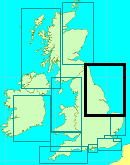You are viewing the expanded version of this Harbour,
for faster browsing
use the regular version here
Filey Anchorage
Courtesy Flag
Flag, Red EnsignWaypoint
Anchorage Area 54:12'.7 N 000:16'.08 WCharts
Admiralty 1882Rules & Regulations
V.Slow speed limit 200m off the beachHazards
Extensive ShallowsTidal Data Times & Range
Tides +0530 Dover Approx.This site is designed for slower, roaming broadband connections, like you would get at sea, so it needs JavaScript enabled to expand the text.
General Description
Filey is another possible passage Anchorage for those pushing North....
.... and perhaps finding themselves beset by north-westerlies and needing a break.
The Anchorage gets some protection from the North from Filey Brigg which projects a good half mile or more from the shore in an easterly direction, thus is capable of providing reasonable shelter in winds from just east of North, anticlockwise round to West.
Filey is a popular little Victorian seaside town and Butlins once had a large holiday camp based here, served by its own railway station.
Dinghy landings can be made on the beach, but there are extensive shallows and you're quite likely to get wet.
Approach
Approaches to Filey from a southerly direction are straightforward, with depths shelving gradually and steadily.
From the North it is necessary to give Filey Brig a suitable offing, by passing round the outside of the easterly Cardinal buoy Filey Brigg (Q(3)10s).
This Anchorage is totally open to the East clockwise through to the South, so it would be wise to keep on top of the weather forecasts for the duration of your stay. Winds from an easterly direction bring in strong surf which is not what you want coming your way at anchor..
Berthing, Mooring & Anchoring
Anchorage can be had at a suitable distance off the town in depths of over 3 m at CD,....
.... or closer in to suit draft. The holding ground is good.You will see the coble landing ramp where locals launch from off the promenade.
Facilities
For those who dinghy it ashore across the shallows, all the delights of a small seaside town await.
A quick rummage around the town will throw up all manner of shops and banks etc. There is also a railway station, but this is hardly a place for crew changes.
Trailer Sailors can use the Coble Landing at Filey. It consists of a shallow concrete and stone slipway leading onto the sand. There is a charge of under eight pounds per day, and access at all tide is possible providing you're prepared to lug your boat by hand in it's trolley across the sands. The site is really only suitable a couple of hours either side of high water for larger boats. The maximum horsepower engine allowed its 12.5, there's a speed limit within 200 m of the shore with waterskiing permitted outside of this area ( Hmmm.. with a 12 hp outboard ?).
History
Filey is a small town and civil parish in North Yorkshire, England. It forms part of the borough of Scarborough and is located between Scarborough and Bridlington on the North Sea coast. Although it started out as a fishing village, it has a large beach and is a popular tourist resort. Until 1974 it was an urban district in the East Riding of Yorkshire.
Filey is at the eastern end of the Cleveland Way, a long-distance footpath; this starts at Helmsley and skirts the North Yorkshire Moors. It was the second National Trail to be opened (1969). It is also the northern end of the Yorkshire Wolds Way which starts at Hessle and crosses the Yorkshire Wolds. Filey is the finishing point for Great Yorkshire Bike Ride. The 70 mile ride begins at Wetherby Racecourse.
Filey has a railway station on the Yorkshire Coast Line. Previously Filey also had a second station Filey Holiday Camp railway station to the south of the town serving the former Butlins holiday camp. This camp has now been re-developed into a 600-home holiday housing development, The Bay Filey. It is one of the largest coastal developments of this kind in the UK and the first homes began to be handed over to buyers in 2007.
In July 2007 Filey was hit by flash floods which caused major problems in the town, with various areas suffering damage.
History
Filey remained a small village until the 18th century when visitors from Scarborough arrived seeking the peace and quiet that Filey offered. Then in 1835 a Birmingham solicitor called John Wilkes Unett bought 7 acres of land and built the Crescent, later known as the Royal Crescent. It was opened in the 1850s and for 100 years it was the most fashionable address in the North of England.
English composer Fredrick Delius stayed as a boy on the Crescent with his family at Miss Hurd's boarding house no 24 in 1876 plus 1877 and at Mrs. Colley's no 24 in 1897.
For more than 40 years Butlin's Holiday camp was a major factor in Filey's economy. Building work began in 1939 and continued through the war during which it became an military base known as R.A.F. Hunmanby Moor. In 1945 it became a popular holiday resort complete with its own railway station and by the late 1950s it could cater for 10,000 holiday makers. Unfortunately it was to close in 1984, causing a decrease in the holiday makers visiting Filey.
The Bonhomme Richard, the famous ship sailed by John Paul Jones, who was a Scottish born American known as the "father of the US Navy", was lost after a fierce landmark battle in 1779 (The Battle of Flamborough Head) in which hundreds died, still remains a mystery and is believed by many to lie somewhere within Filey Bay. The Bonhomme Richard fought in the Battle and even through its eventual sinking, the outcome of the battle convinced the French crown to back the colonies in their fight to separate from British authority. The location of the Bonhomme Richard to this day is unknown, and numerous expeditions have been undertaken to try and locate her, however, decades of fishing trawling and numerous other wrecks have made this procedure complicated. So far, she has not been located.
The text on this HISTORY page is covered by the following licence
http://en.wikipedia.org/wiki/Wikipedia:Text_of_the_GNU_Free_Documentation_License
Eating, Drinking & Entertainment
For the skipper prepared to leave his boat at anchor there are opportunities ashore, to relax while keeping a weather eye on the boat. The intrepid skipper however is unlikely to get ashore without getting pretty wet...
Links
|
Your Ratings & Comments







